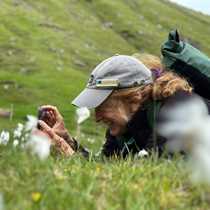Stuart Island
Stuart Island Marine State Park was the location for our first investigative foray as we start our trip northward, ultimately bound for Juneau, Alaska. The Sea Bird maneuvered carefully into the protective arms of Prevost Harbor. Prevost Harbor, named in 1859 by the British Admiralty surveyor, Capt. Richards, RN, for Capt. James Charles Prevost. Capt. Prevost had commanded the HMS Satellite on this station in the 1850s. A small island in Prevost Harbor bears the name of his ship as well, Satellite Island. As for Stuart Island, it was named in 1841 by Cmdr. Wilkes for Frederick D. Stuart, captain’s clerk on the Peacock. This is not the first name the island has held; the Lummi Indian name was Qunnis, meaning “whale.”
As we exercised, stretched our legs and ambled around the island, we were introduced to some of the interesting flora. Catching most everyone’s eye was the smooth, red bark possessed by Arbutus menziesii or Pacific Madrone. We couldn’t help but stroke the silky smooth trunk of the “strawberry tree” named for its bright red berries borne after the clusters of creamy urn-shaped flowers have blossomed. Sometimes what catches the eye, especially when the pace is an investigative mosey, are the finer, delicate details. Such is the case with the photo we share with you today, a delicate western starflower. The flower stalks are extremely thin, giving the illusion of flowers suspended in mid air, like tiny woodland stars.
For the afternoon we headed away from Stuart Island, only to be led back by a small pod of Killer whales. Smooth, glistening dorsal fins rhythmically broke the surface of the water as the whales emerged for a quick exhale, and just as quick inhale, of fresh air. One whale displayed a bit more surface activity and teased us with a quick spy hop. After several minutes, it went for broke with a full body breach, accompanied by a grand splash. This was a temporary display of exuberance, and this whale soon fell back into a rhythm of regular surfacings and breaths.
From the tiny flowers on an island, to the large toothed mammals prowling the waters of Haro Strait, our day has encompassed a variety of new sightings and discoveries. We’ll continue northbound, looking for more of the details, both large and small that make a voyage memorable.
Stuart Island Marine State Park was the location for our first investigative foray as we start our trip northward, ultimately bound for Juneau, Alaska. The Sea Bird maneuvered carefully into the protective arms of Prevost Harbor. Prevost Harbor, named in 1859 by the British Admiralty surveyor, Capt. Richards, RN, for Capt. James Charles Prevost. Capt. Prevost had commanded the HMS Satellite on this station in the 1850s. A small island in Prevost Harbor bears the name of his ship as well, Satellite Island. As for Stuart Island, it was named in 1841 by Cmdr. Wilkes for Frederick D. Stuart, captain’s clerk on the Peacock. This is not the first name the island has held; the Lummi Indian name was Qunnis, meaning “whale.”
As we exercised, stretched our legs and ambled around the island, we were introduced to some of the interesting flora. Catching most everyone’s eye was the smooth, red bark possessed by Arbutus menziesii or Pacific Madrone. We couldn’t help but stroke the silky smooth trunk of the “strawberry tree” named for its bright red berries borne after the clusters of creamy urn-shaped flowers have blossomed. Sometimes what catches the eye, especially when the pace is an investigative mosey, are the finer, delicate details. Such is the case with the photo we share with you today, a delicate western starflower. The flower stalks are extremely thin, giving the illusion of flowers suspended in mid air, like tiny woodland stars.
For the afternoon we headed away from Stuart Island, only to be led back by a small pod of Killer whales. Smooth, glistening dorsal fins rhythmically broke the surface of the water as the whales emerged for a quick exhale, and just as quick inhale, of fresh air. One whale displayed a bit more surface activity and teased us with a quick spy hop. After several minutes, it went for broke with a full body breach, accompanied by a grand splash. This was a temporary display of exuberance, and this whale soon fell back into a rhythm of regular surfacings and breaths.
From the tiny flowers on an island, to the large toothed mammals prowling the waters of Haro Strait, our day has encompassed a variety of new sightings and discoveries. We’ll continue northbound, looking for more of the details, both large and small that make a voyage memorable.




